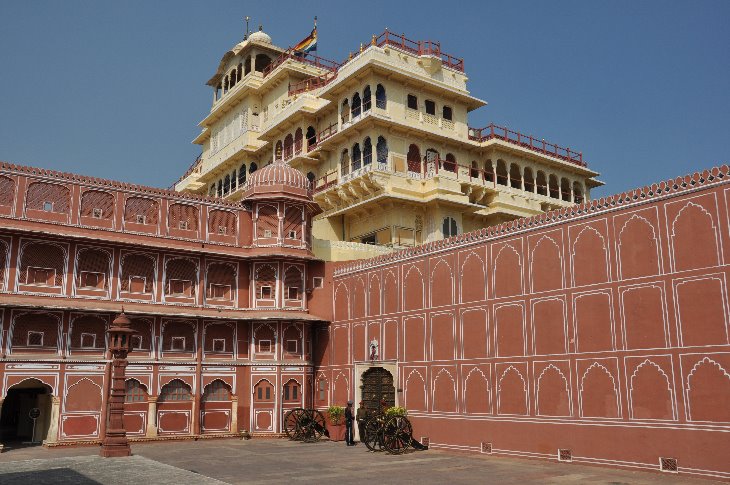
17.February, Jaipur – AMER FORT, CITY PALACE, WIND PALACE und the famous Observatory
We were up before sunrise for an early start to the Amer Fort, built in red sandstone and marble, which was beautiful in the light of dawn across the Maotha Lake. We had an enjoyable ride up to it on elephants. Situated in Amber, 11 kilometers from Jaipur, it is one of the most famous forts of Rajasthan. It is an old fort, built in 1592 by Raja Man Singh, and has influences of both Hindu and Muslim architecture. This was followed by a visit to the City Palace built in the 17th. century, before lunch and returning to the hotel. The whole day in Jaipur was fine and the palaces are very impressive and well preserved.
Late afternoon we visited an astrological observatory also from the same time, which consisted of lots of ramps and semicircular constructions which allowed accurate observations of the stars. It all actually looked more a modern art work. After that and a rather hair raising rickshaw ride, we were taken to a carpet factory and of course shown lots of carpets. I asked if they had a runner long enough for my landing (7m.). After first saying they did not make that size (which I had heard before) one was produced, which I bought! It has the traditional Hamdran pattern in rectangles. There was another colourful dance offering in the evening.
Humayun (1508 – 1556) son of Babur was the second emperor of the Mughal Empire, who ruled over territory in what is now Afghanistan, Pakistan, and parts of northern India from 1530–1540 and again from 1555–1556. His half-brother Kamran Mirza inherited Kabul and Lahore, the northernmost parts of their father’s empire. At the age of 23, Humayun was an inexperienced ruler when he came to power. He lost Mughal territories to Sher Shah Suri, but regained them with additional territory 15 years later with the aid of the Safavid dynasty of Persia.
Humayun’s return from Persia was accompanied by a large retinue of Persian noblemen and signalled an important change in Mughal court culture. The Central Asian origins of the dynasty were largely overshadowed by the influences of Persian art, architecture, language and literature. There are many stone carvings and thousands of Persian manuscripts in India dating from the time of Humayun. Subsequently he further expanded the Empire in a very short time, leaving a substantial legacy for his son, Akbar. At the time of his death in 1556, the Mughal Empire spanned almost one million square kilometres. His peaceful personality, patience and non-provocative methods of speech earned him the title ’Insān-i-Kamil (Perfect Man), among the Mughals.


























